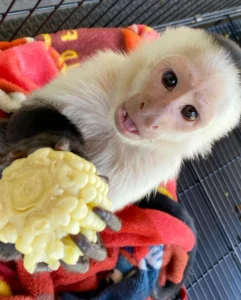 While reading about the G-20 summit held earlier this month in New Delhi, I stumbled upon a story about rhesus macaques, a species of monkeys considered an urban menace in India. Officials were trying to keep the monkeys from stealing the spotlight during the summit. Also from stealing food from dining tables and from making themselves at home on subways trains and from chasing pedestrians down the street, all of which rhesus monkeys are, apparently, wont to do.
While reading about the G-20 summit held earlier this month in New Delhi, I stumbled upon a story about rhesus macaques, a species of monkeys considered an urban menace in India. Officials were trying to keep the monkeys from stealing the spotlight during the summit. Also from stealing food from dining tables and from making themselves at home on subways trains and from chasing pedestrians down the street, all of which rhesus monkeys are, apparently, wont to do.
My mind flashed back to a scene that took place in a big box sporting goods store here in Cookeville several weeks ago.
I was trying to decide whether a pair of running shoes, which were on sale for a great price, were too ugly to consider buying. They were a peachy-pink color, which would never be my first choice, and had squiggly vertical lines running the length of the shoe. I had laced them up and tied them on and was turning this way and that in front of the floor mirror when I spotted a woman walking toward me, carrying what I at first thought was a tiny baby.
On closer inspection, I discovered that the diminutive creature in her arms was not human.
Always on the lookout for a newspaper column, I forgot all about the shoes I was test driving. “Is that a monkey?” I asked, knowing full well it was. I’m no zoologist, but I know a monkey when I see one.
She nodded. Naturally, I began peppering her, and the man with her, with questions. This was not a rhesus but a juvenile capuchin, which you might be familiar with as an organ grinder’s monkey, though I’m not sure there’s still such a thing as an organ grinder. Capuchins are the most common pet monkeys in the world. They grow to between three and nine pounds and can be almost two feet tall, with a tail typically as long as the body.
I noticed right off that the monkey had a pacifier in her mouth. She was also wearing a diaper. “She always will,” the owner told me. “These monkeys are highly intelligent but they can’t be potty-trained.” She told me that she and her husband never leave the monkey home alone (“she doesn’t like being in a cage and monkey babysitters are hard to come by”) and that they have to go all the way to Murfreesboro for veterinary care, which is very expensive.
I asked a few more questions but sensed the couple was growing tired of answering them, especially after the man said “I’ll never understand why, everywhere we go, people ask about our monkey.”
“Really?” I almost said, but didn’t.
Then the woman raised the monkey’s face to hers and gave it a big ole sloppy kiss. “She’s our baby,” she told me, and then they walked away.
The minute I got home I began researching capuchin monkeys. I learned that they’re native to South America and cost between $4,000 and $12,000. Their life expectancy in the wild is about 25 years but they can live much longer in captivity. Humans are often attracted to monkeys as pets because they’re “like us”—ten fingers, ten toes, and a human-like face.
But there are plenty of downsides to living with monkeys. They’re loud, messy, destructive and they bite. They like to soak their hands and feet in urine to leave a scent wherever they go. Monkeys don’t mix well with human children. Though monkeys are occasionally trained as service animals, the American Veterinary Medical Association does not support their use as such because of concerns over animal welfare, the potential for serious injury to people and the risk of transferring disease between monkeys and people.
Truthfully, I was glad when the folks with the monkey baby walked away. First off, because it didn’t bite me. And I had time to decide that the ugly peachy-pink running shoes suited me just fine.
(September 16, 2023)